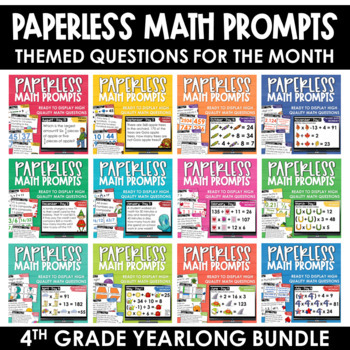PAPERLESS Math Morning Work YEARLONG Math Spiral Review Bundle 4th Grade
Tanya Yero Teaching
27.4k Followers
Grade Levels
4th, Homeschool
Subjects
Resource Type
Standards
CCSS4.MD.A.1
CCSS4.MD.A.2
CCSS4.MD.A.3
CCSS4.MD.B.4
CCSS4.MD.C.5
Formats Included
- Zip
- Google Apps™
Pages
125+
Tanya Yero Teaching
27.4k Followers

Includes Google Apps™
The Teacher-Author indicated this resource includes assets from Google Workspace (e.g. docs, slides, etc.).
What educators are saying
These paperless math prompts has really helped students to express themselves in math. They have also enjoyed how colorful and classroom friendlyn they were to use.
Students love these! Maybe because they are paperless and can do the activities in their heads, but they still love them!
Description
Looking for new ways to get your students hooked on math? Need morning work to display on the board so you can take attendance? We got you covered!
Having quality math prompts on hand has never been so easy! Our Paperless math prompts are ready to display math questions on high interest topics that promote problem solving. Each set of 20 questions is themed for that particular month.
What grade levels are these activities designed for? 4th grade - We have written the prompts in such a way to try to ensure that topics for 4th graders have been taught by that particular month.
Use these prompts for:
- Math hooks
- Morning work/ bell ringers
- Small group instruction
- Number talk discussions
- Prompting problem solving
- Building number sense
What are the topics for each day?
- MYSTERY MATH MONDAY– Students will use deductive reasoning to find the value of each symbol in the equations provided.
- TRUE OR FALSE TUESDAY– Students will decide if the statement provided is true or false. Make sure they provide an explanation with their answer!
- WHO IS THE IMPOSTER WEDNESDAY– Students will decide which number doesn’t belong in the group. Anything goes with this category as long as they can mathematically justify their answer!
- THINK TANK THURSDAY– This day has themed word problems that promote problem solving and relate to the season.
- FOR REAL FRIDAY– Students will solve real world applicable prompts.
What's included for each month?
- PowerPoint version of the prompts
- Google Slides version of the prompts
- Answer key
Benefits of this resource:
- Whether you are in a traditional classroom setting, completing distancing learning, or a mix of both you’ll have resources for morning work, extra practice or when you find yourself with 5 extra minutes in the classroom
- NO PREP
- Academically engaging
- High interest activities and topics
- Promotes problem solving
- Builds number sense
Who should purchase this resource?
- Teachers looking for resources that can be used in the classroom and for distance learning
- Teachers looking for resources that require deep thinking
- Teachers looking for READY TO GO math activities
- Teachers wanting ZERO PREP math activities
Total Pages
125+
Answer Key
Included
Teaching Duration
1 Year
Report this resource to TPT
Reported resources will be reviewed by our team. Report this resource to let us know if this resource violates TPT’s content guidelines.
Standards
to see state-specific standards (only available in the US).
CCSS4.MD.A.1
Know relative sizes of measurement units within one system of units including km, m, cm; kg, g; lb, oz.; l, ml; hr, min, sec. Within a single system of measurement, express measurements in a larger unit in terms of a smaller unit. Record measurement equivalents in a two-column table. For example, know that 1 ft is 12 times as long as 1 in. Express the length of a 4 ft snake as 48 in. Generate a conversion table for feet and inches listing the number pairs (1, 12), (2, 24), (3, 36),...
CCSS4.MD.A.2
Use the four operations to solve word problems involving distances, intervals of time, liquid volumes, masses of objects, and money, including problems involving simple fractions or decimals, and problems that require expressing measurements given in a larger unit in terms of a smaller unit. Represent measurement quantities using diagrams such as number line diagrams that feature a measurement scale.
CCSS4.MD.A.3
Apply the area and perimeter formulas for rectangles in real world and mathematical problems. For example, find the width of a rectangular room given the area of the flooring and the length, by viewing the area formula as a multiplication equation with an unknown factor.
CCSS4.MD.B.4
Make a line plot to display a data set of measurements in fractions of a unit (1/2, 1/4, 1/8). Solve problems involving addition and subtraction of fractions by using information presented in line plots. For example, from a line plot find and interpret the difference in length between the longest and shortest specimens in an insect collection.
CCSS4.MD.C.5
Recognize angles as geometric shapes that are formed wherever two rays share a common endpoint, and understand concepts of angle measurement:





